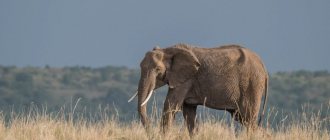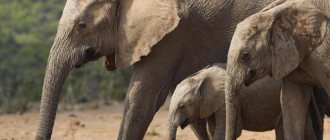Elephants are large herbivorous mammals from the order Proboscis. All living species of elephants belong to the elephant family. The first primitive ancestors of modern proboscideans, the skeletons of which were found in Africa, appeared more than 50 million years ago. These were relatively small animals (maximum weight - 300 kg) with a just developing trunk and small tusks. Meriteria and Deinotherium, which appeared 10-20 million years ago, already had a visible trunk formed from the nose and upper lip. The closest in terms of evolution to the proboscis family are mastodons and mammoths, which became extinct about 10 thousand years ago.
The origin of the word elephant is not known for certain. According to one version, it is a modified form of the Turkic word arslan, which means lion, that is, a very large and strong animal. Another hypothesis for the etymology of the name is related to the fact that the animal sleeps standing, leaning against a tree or other support.
Characteristics and description of the animal
Elephants are the largest land mammals. The way of life of animals has its own characteristics. They live in large groups, in which the oldest and most experienced female dominates. Typically, a herd of elephants consists of related females and their calves. Sexually mature males live either alone or form small groups.
An elephant's brain weighs 7 kg. This is not so much, considering the weight of the animal. However, elephants have a fairly developed intelligence and good visual memory. Their vision is not very well developed, but their hearing is many times superior to that of humans, and their excellent sense of smell allows them to distinguish odors whose source is located several kilometers away.
Animals have the ability to thermoregulate. On hot days, the elephant's body temperature decreases due to the flapping of its ears, riddled with blood vessels. The blood cooled in this way returns to the body, maintaining a stable body temperature at +36 degrees.
Elephants can swim, covering distances of several tens of kilometers, and walk underwater, raising their trunk to the surface.
Adult elephants have no natural enemies. Only fragile elephant calves under 2 years of age suffer from attacks by predators. Large cats, crocodiles and packs of hyenas can attack them.
What sounds does an elephant make?
What does it look like
The characteristic features of the appearance of elephants are as follows:
| Body | Large, short, tail almost equal in length to the hind limbs |
| Head | Large, round, small eyes, nose and upper lip form a long trunk, adults have tusks |
| Ears | Large, rectangular or triangular in shape |
| Legs | Thick and massive, slightly expanding at the bottom, in the center of the foot there is a fat pad that serves as a shock absorber |
| Color | Shades of gray and brown |
Dimensions and weight
The average weight of a newborn elephant is 100 kg. Animals continue to grow until they reach sexual maturity, and gain weight until they are 20-25 years old. The maximum weight of an elephant and its height at the withers depends on the variety. The largest representatives of the family are the inhabitants of Africa, whose weight reaches 6-8 tons or more, and their height is 4 m.
Tusks
In elephants, tusks were formed as a result of elongation of the lateral incisors of the upper jaw. They grow throughout life, which makes it possible to determine the age of the animal. The weight of tusks in old males can reach 90 kg.
Natural conditions
The cubs of these giants are often in danger of being eaten by predators. Elephants that have survived the childhood period have no natural enemies, with the exception of humans. If the animal can survive several long droughts throughout its life and find six hundred kilograms of greenery and two hundred liters of water, if it does not become the prey of poachers, then the average life expectancy of an elephant will be about seventy years.
Types of elephants
The elephant family includes several species that have certain differences in appearance and size.
African
The species unites elephants living on the African continent. All of them are characterized by the rectangular shape of their ears, the size of which is noticeably larger than those of Asian ears. Another feature of the species is the presence of two grasping fingers on the trunk. In the taxonomy there are two separate subspecies: forest and savannah. Let's take a closer look at the second of them.
Savannah
Of all the representatives of the family, savannah elephants are the largest and most massive. This is perhaps the only subspecies that cannot be taught or trained.
Asiatic
Combines the Sumatran and Ceylon subspecies of elephants. The name of the varieties indicates the habitat of the populations. Characteristic features of these two subspecies are medium body size and the almost complete absence of tusks.
Bornean
A dwarf subspecies of the Asian elephant that lives on the island of Kalimantan. The Bornean elephant can be recognized by its very long and thick tail, as well as a noticeable hump at the withers.
Indian
The second largest elephant with a large body and relatively short legs. There are two characteristic bulges on the forehead. In the color of some individuals, unpigmented areas are noticeable. Albinos are found among Indian elephants.
Maltese dwarf
An extinct subspecies of the Asian elephant that once lived on the islands of the Mediterranean Sea. Restoration of the found skeletons of the animal indicates that their height did not exceed 1 m, and their weight did not exceed 300 kg.
Meaning for humans
The Indian elephant is easy to tame and train. For many centuries in southeast Asia, Indian elephants were used as riding and draft animals. They typically carried loads and trees in logging operations. Young individuals could be used only after reaching 7 years of age, for difficult work - from 12. Elephants that were more than 30 years old were no longer suitable for work and training, therefore, when captured, they were immediately released. Tamed wild animals were also needed in battles. But now this is a thing of the past. However, Indian elephants are used as mounts where there is no transport.
How do they reproduce?
Female elephants mature at the age of 11-14 years, their reproductive function remains up to 50 years. In males, puberty occurs by the age of 15 and is first manifested by the release of a sharp-smelling secretion from the temporal glands located between the eye and ear. Increased activity of the temporal glands indicates the beginning of must - the period when the male is ready to mate. It lasts on average about a month.
Must in elephants is accompanied by a significant increase in testosterone levels and frequent urination. Animals with a relatively calm character become aggressive. During this time, captive individuals are exempt from work or performance.
Elephant reproduction is not seasonal. Females, ready to mate, separate from the herd and emit calling calls. The mating season lasts about two weeks, after which the animals return to their groups.
How long does a mother elephant carry a baby elephant?
Pregnancy lasts 22 months, after which one baby elephant is born. The next time the elephant will be ready for mating only after 6-8 months.
Sometimes there are albinos among elephant calves. They are not completely white, but with a slightly pinkish or grayish tint. In Asia, albinos are still considered a symbol of royal power. The rulers of Thailand, Myanmar and other Asian countries have white elephants.
HIPPOPOTAMUS
Where do they live?
The habitat of elephants is the African continent and the southeastern part of Asia. In Africa, giants are found in many countries located south of the Sahara Desert. In Asia, the most numerous populations live in India, Thailand, China, and Malaysia.
The decline in elephant numbers in recent decades is caused by human economic activity and poaching for valuable tusks and meat. In order to preserve the population, the animal was included in the IUCN register, and numerous reserves were created in its habitats.
Where live
The elephant's natural habitat is savannas, tall grass meadows, and tropical forests. Animals are found in flat areas with sufficient food supply.
Population
The Indian elephant population is declining. According to some estimates, about 5 percent of these mammals die every year. In 1986, they were listed in the IUCN Red List, because this species was almost on the verge of extinction - the population had decreased by half. To protect animals, they launched the “Elephant” project. This was done to help spread the species. It is also needed to protect elephant migration routes. The project improves veterinary care for wild animals.
There is a special protected haven for Indian elephants in northeast India. The largest population of animals in the country is concentrated there. Now the Wildlife Fund is trying to protect these individuals.
What do they eat?
Elephants need a lot of food. An adult animal can eat up to 300 kg of green mass per day. Food includes grass, leaves, young shoots, fruits and bark of trees and shrubs. Giants kept in captivity eat hay, grain, and a variety of vegetables and fruits.
Elephant calves that have just started eating solid food periodically eat the droppings of adult animals to obtain intestinal microflora. This makes it possible to get the maximum benefit from the herb for sustainable weight gain.
RHINOCEROS
Giants in captivity
The life expectancy of an elephant in a zoo is significantly lower. There are only isolated cases of animals dying at the age of 80, and only in Thailand. But no matter how proper feeding and proper care may be, elephants are social animals, they need their own kind.
In their natural environment, they live in groups - families. The male is with his mother from birth until he is fifteen years old. The female remains with her female relatives until death. Daily exercise reaches tens of kilometers. In zoos the conditions are completely different. Physical, social and psychological needs are not met here in the same way as in the wild. Zoos do not have enough territory for the normal life of elephants. In addition, they are often separated and sent to other zoos for breeding. Therefore, giants in captivity get sick, and the life expectancy of an elephant is only 18–20 years.
Why does an elephant need a trunk?
Among the ancient ancestors of the elephant, who were semi-aquatic animals, the trunk was used exclusively for breathing when immersed under water. Subsequently, it stretched out, the structure was supplemented by numerous groups of circular and longitudinal muscles, and a finger-like process formed at the end. All this significantly expanded the functionality of the trunk. With its help, the animal reaches tree branches and plucks grass. During a watering session, the elephant takes 6-7 liters of water inside and then pours it into its mouth. Using its trunk, the elephant trumpets - produces a characteristic roar, using its elongated nose as a wind instrument. When moving a herd over long distances, the babies usually follow the females and at the same time hold onto their tail with their trunks.
Why are elephants afraid of mice?
Pliny the Elder mentioned that elephants hate mice in his Natural History, written more than 2000 years ago. However, experiments conducted by researchers and trainers of giant mammals refute this widely held belief. Most likely, a certain negative reaction to rodents is caused by their sudden movements. Elephants, who do not have very good eyesight, are unlikely to notice a mouse that sits motionless, but they immediately identify even small objects that move quickly and at the same time show concern.
Another version is that the rustling noise made by a running rodent resembles the sound of a creeping predator.
GIRAFFE
Life of giants in national parks
The longest life expectancy of an elephant is observed here. They live practically in the wild, but are under the supervision and protection of the state. They are not afraid of poachers and hunters. Animals are periodically examined and in case of any illness or injury, medical care is provided. If it is noticed that the elephant cannot feed itself or the baby elephant is left without a mother, they will be placed in a nursery. There, the adult giant will be cared for until death, and the little one will be released into the park when he grows up.
Interesting facts about elephants
- Elephants are slow animals. The speed of herds slowly walking in search of food or water reaches 3-5 km/h. Elephants can run, but they get tired very quickly. The maximum speed of an elephant is 40 km/h.
- Since 2011, the world has been celebrating International Elephant Day. As part of the celebration, which takes place on August 12, organizers disseminate information about the peculiarities of the animals' lifestyle and the need to protect them.
- The thickness of an elephant's skin reaches 2-4 cm, but the skin does not have sweat glands and is highly sensitive. The biggest inconveniences for giants are the scorching sun's rays and insects. To protect themselves from ultraviolet radiation and protect themselves from bites, elephants sprinkle sand on themselves after bathing. The resulting crust becomes a reliable protection for the skin of the mammal.
- The world's largest elephant was killed in Angola. The weight of the huge male exceeded 12 tons.
- Elephants communicate with each other using sounds, trunk waves, and posture changes. To transmit information to members of their herd located at a considerable distance, animals use low-frequency waves. The maximum distance at which elephants can hear their relatives is 10 km.
- Elephants are truly gigantic animals: the length of their trunk reaches 2 m, their tusks are 2.5 meters, the distance between the tips of their ears is 3 m, and their heart weighs 30 kg!











